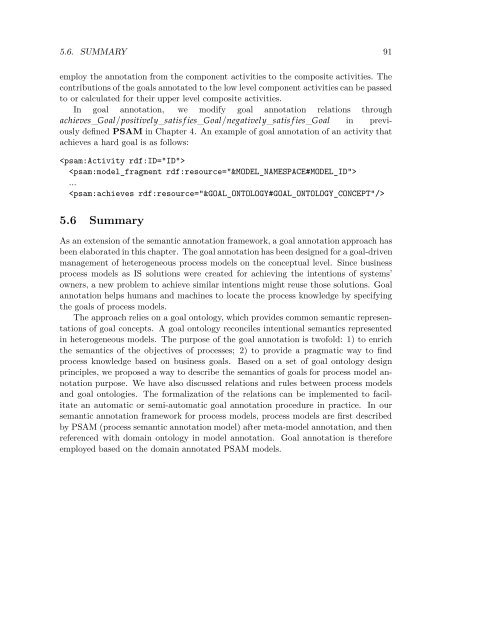Semantic Annotation for Process Models: - Department of Computer ...
Semantic Annotation for Process Models: - Department of Computer ...
Semantic Annotation for Process Models: - Department of Computer ...
You also want an ePaper? Increase the reach of your titles
YUMPU automatically turns print PDFs into web optimized ePapers that Google loves.
5.6. SUMMARY 91<br />
employ the annotation from the component activities to the composite activities. The<br />
contributions <strong>of</strong> the goals annotated to the low level component activities can be passed<br />
to or calculated <strong>for</strong> their upper level composite activities.<br />
In goal annotation, we modify goal annotation relations through<br />
achieves_Goal/positively_satis f ies_Goal/negatively_satis f ies_Goal in previously<br />
defined PSAM in Chapter 4. An example <strong>of</strong> goal annotation <strong>of</strong> an activity that<br />
achieves a hard goal is as follows:<br />
<br />
<br />
...<br />
<br />
5.6 Summary<br />
As an extension <strong>of</strong> the semantic annotation framework, a goal annotation approach has<br />
been elaborated in this chapter. The goal annotation has been designed <strong>for</strong> a goal-driven<br />
management <strong>of</strong> heterogeneous process models on the conceptual level. Since business<br />
process models as IS solutions were created <strong>for</strong> achieving the intentions <strong>of</strong> systems’<br />
owners, a new problem to achieve similar intentions might reuse those solutions. Goal<br />
annotation helps humans and machines to locate the process knowledge by specifying<br />
the goals <strong>of</strong> process models.<br />
The approach relies on a goal ontology, which provides common semantic representations<br />
<strong>of</strong> goal concepts. A goal ontology reconciles intentional semantics represented<br />
in heterogeneous models. The purpose <strong>of</strong> the goal annotation is tw<strong>of</strong>old: 1) to enrich<br />
the semantics <strong>of</strong> the objectives <strong>of</strong> processes; 2) to provide a pragmatic way to find<br />
process knowledge based on business goals. Based on a set <strong>of</strong> goal ontology design<br />
principles, we proposed a way to describe the semantics <strong>of</strong> goals <strong>for</strong> process model annotation<br />
purpose. We have also discussed relations and rules between process models<br />
and goal ontologies. The <strong>for</strong>malization <strong>of</strong> the relations can be implemented to facilitate<br />
an automatic or semi-automatic goal annotation procedure in practice. In our<br />
semantic annotation framework <strong>for</strong> process models, process models are first described<br />
by PSAM (process semantic annotation model) after meta-model annotation, and then<br />
referenced with domain ontology in model annotation. Goal annotation is there<strong>for</strong>e<br />
employed based on the domain annotated PSAM models.
















